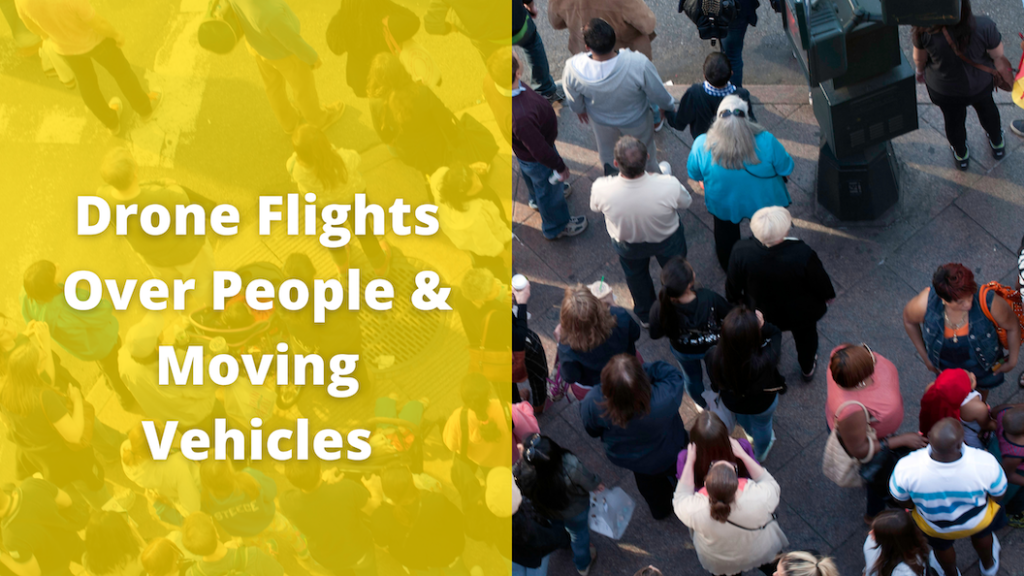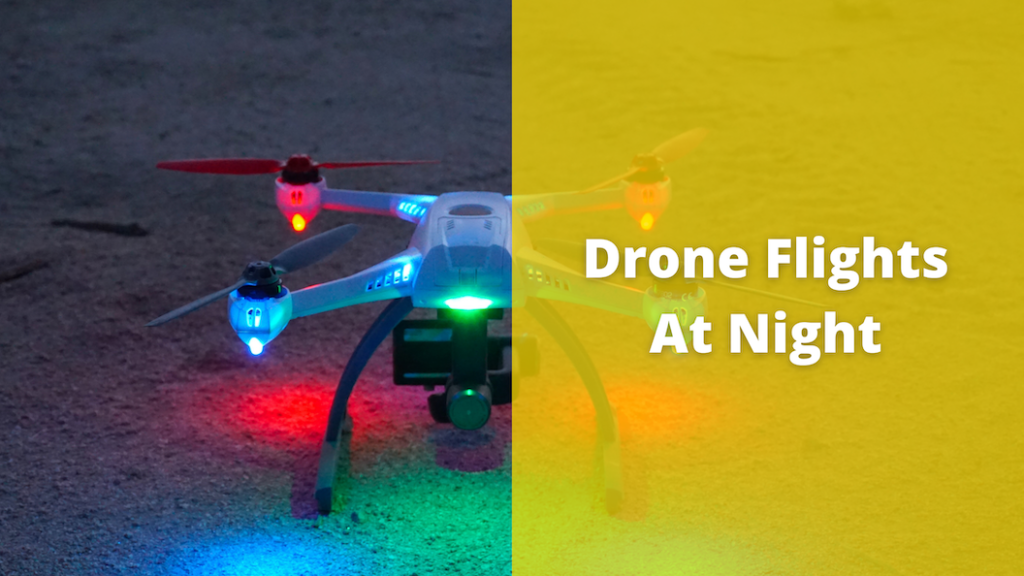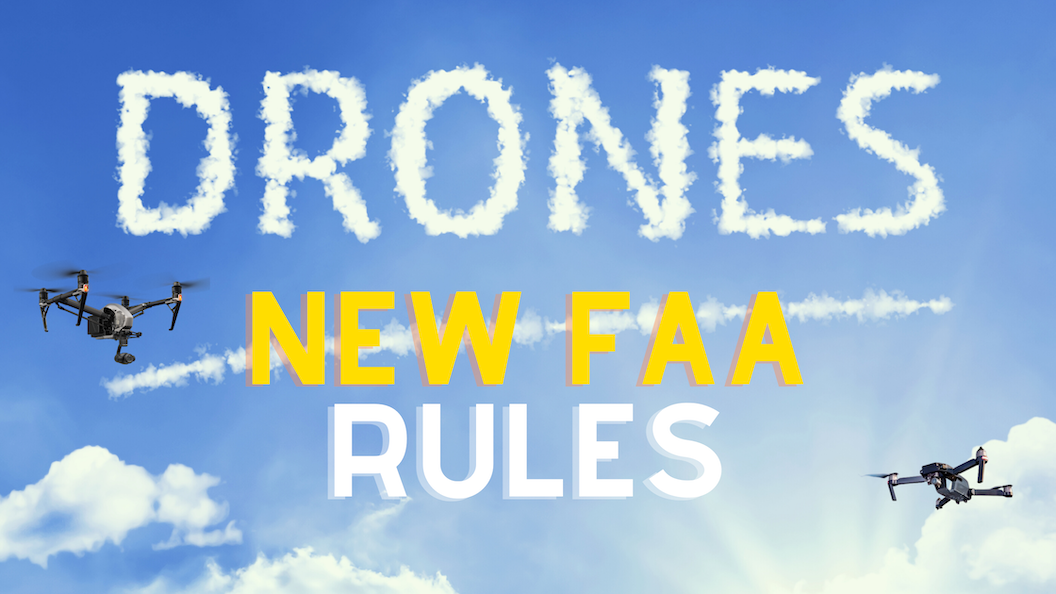Update: According to the FAA, the final rules requiring remote identification of drones and allowing some flights over people, over moving vehicles, and at night under certain conditions will go into effect on April 21, 2021.
————
The new rules for Remote ID will also go into effect on April 21. Within 18 months, UAS manufacturers selling in the U.S. will have to incorporate remote ID capabilities on all drones above the size standard. Drone pilots will have two and a half years to install such capabilities on their existing drones or buy new, compliant UAS.
New Drone Rules Are Here
On December 28, the FAA released two long-awaited rules that cover Remote ID and revisions to Part 107 rules, namely flights at night and over people/moving vehicles.
The rules seem pretty straightforward at first glance – with the framework of implementing Remote ID explained, and the opening of flights over people and at night, given certain conditions – but given the fact that the FAA document that spells out and explains the new rules is 292 pages, there are plenty of details that need to be filled in, and questions that remain to be answered.
The Big Picture
The new rules are part of the FAA’s ultimate goal to enable routine drone operations in the same airspace as manned aircraft. But, there is still work to be done before that is achievable. In a recent article in Forbes, Kristy Kiernan, Assistant Professor at Embry-Riddle Aeronautical University, explained the process is, “like a game of Chutes and Ladders, many small moves and a couple of big ones are required to reach that goal, and along the way, there is an ever-present danger of sliding backwards.”
The two new rules are ladders toward the goal, but more ladders are needed to reach it.
Understanding the New RulesMost media coverage focuses on the Remote ID rule, and rightly so, as it is the keystone to the widespread safe integration of drones into the National Airspace. However, it is also the rule whose final implementation is over two years away; and which still requires a mountain of work. The more immediate impact will be the new rules that open up drone flights over people/moving vehicles and at night. Below, we go over these two rules in detail. (If you want to look into them further on your own, read the final FAA rule in its entirety here.)

#1 Drone Flights Over People/Moving Vehicles
This rule allows expanded routine operations of small unmanned aircraft over people and moving vehicles without the need for a waiver or exemption, under certain conditions.
But before you get too excited and think you now have free reign to fly your drone over crowds of people, don’t forget the end of the sentence, “under certain conditions”.
Overview
-The rules go into effect Fri, Feb 26 (60 days after their release on Dec 28).
-This process will replace the need to obtain a waiver or exemption from the FAA but will be limited by Remote ID compliance.
-Drones are grouped into 4 categories, each with certain requirements to fly over people and moving vehicles.
Category 1: Drones under 0.55 pounds with no exposed rotors that can cause lacerations will be allowed to fly over people and moving vehicles, however, cannot operate sustained flight over people or moving vehicles (like hovering or a flight that stays over people the whole time) without Remote ID capability.
Category 2: Drones over 0.55 pounds that have an FAA-issued Declaration of Compliance that the drone does not cause more than 11 foot-pounds (ft-lbs) of kinetic energy upon impact, and that have no exposed rotors that can cause lacerations, will be allowed to fly over people and moving vehicles. Additionally, to be compliant, the drone must have a label indicating its eligibility to conduct category 2 operations. However, like other categories, category 2 drones cannot operate sustained flight over people or moving vehicles (like hovering or a flight that stays over people the whole time) without Remote ID capability.
Category 3: Drones over 0.55 pounds that have an FAA Declaration of Compliance that the drone does not cause more than 25 foot-pounds (ft-lbs) of kinetic energy upon impact, and that have no exposed rotors that can cause lacerations, will be allowed to fly over people and moving vehicles. Additionally, to be compliant, the drone must have a label indicating its eligibility to conduct category 3 operations. However, like other categories, category 3 drones cannot operate sustained flight over people and moving vehicles (like hovering or a flight that stays over people the whole time) without Remote ID capability.
Category 4: Drones that have an FAA-issued airworthiness certificate (under Part 21) will be allowed to fly over people and moving vehicles. As with other categories, category 4 drones cannot operate sustained flight over people or moving vehicles (like hovering or a flight that stays over people the whole time) without Remote ID capability.
Questions That Need To Be Answered
I told you this would not be as simple as it sounds! There are still unanswered questions about meeting the qualifications to fly non-sustained flights over people according to the categories above.
1-What is the standard the FAA will accept to meet the requirement that a drone does not have exposed rotors that can cause lacerations (affecting categories 1-3)?
(Available Info: So far, the FAA has said it will accept a wide variety of requirements like propeller guards and propeller stop mechanisms, but no clear standard has been set or approved.)
2-How does a drone pilot go about getting a Declaration of compliance for drones that fall under category 2 and 3 operations?
(Available Info: The FAA expects manufacturers generally will conduct the required testing and declare compliance with the requirements of Category 2 or Category 3, rather than operators and remote pilots. However, they are leaving the door open for individuals to go through this process for home-made or home-modified drones.)
3-How will I know if my drone is compliant with category restrictions?
(Available Info: The FAA will indicate acceptance of a means of compliance by publishing a Notice of Availability in the Federal Register identifying the means of compliance as accepted.)
The Bottom Line
Drone flights over people and over moving vehicles are opening up but will not be allowed to be completely open until drones meet Remote ID requirements, which in some cases is over 2 years away. In the short term, drones will be allowed to operate non-sustained flights over people and moving vehicles when they meet requirements that are still being clarified and will hopefully be clear when the rules go into effect on 2/26/2021.

#2 Drone Flights At Night
This rule allows routine operations of small unmanned aircraft at night under two conditions. Thankfully, these conditions are much more straightforward compared to the conditions for flights over people and moving vehicles.
Condition 1-The remote pilot in command must complete an initial knowledge test or recurrent training to ensure familiarity with the risks and appropriate mitigations for nighttime operations.
Condition 2-The small unmanned aircraft must have active anti-collision lighting visible for at least 3 statute miles with a flash rate sufficient to avoid a collision.
Questions That Need To Be Answered
1-What is the test that will have to be passed for nighttime operations?
(Available Info: Right now, the FAA is still working on creating this test. According to the FAA, the updated testing and recurrent training required to conduct night operations will be made available on the FAA website 45 days after publication, 2/11/2021.)
2-What about nighttime operational waivers I already have for operations that will be conducted after this rule goes into effect on 2/26/2021?
(Available Info: All night waivers issued prior to the effective date of this rule that authorize deviation from § 107.29 Daylight Operation terminate 120 days after publication, 4/27/2021.)
The Bottom Line
Drone flights at night will effectively be open as of 2/26/2021 as long as the two requirements above are met.


